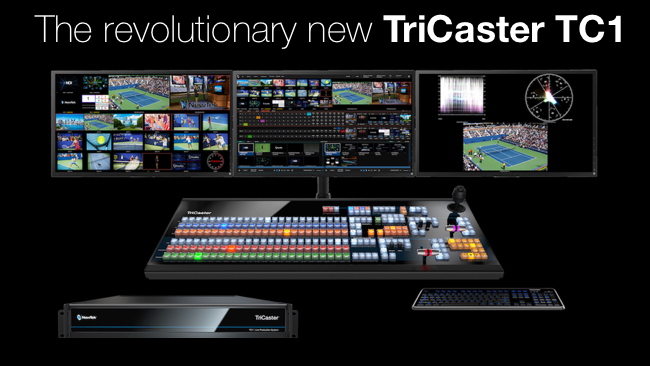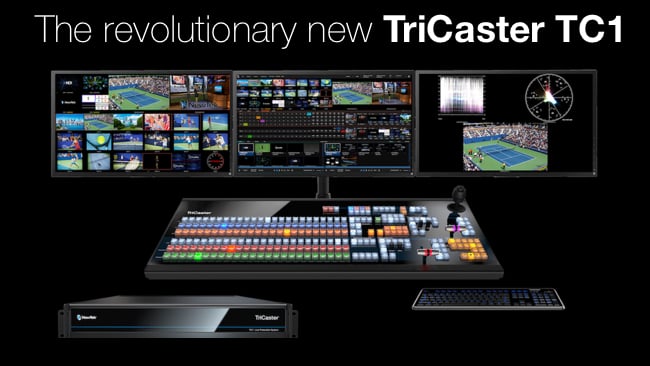
 The latest Tricaster: Fully updated and 4K capable
The latest Tricaster: Fully updated and 4K capable
NewTek’s TriCaster TC1 is a completely new generation of product, built around IP video from the ground-up.
It’s probably correct to say that no-one has been working with digital video production on computers longer than NewTek. This is important to know not just from a historical perspective but because when it started in this business, working with any type of video on any type of computer was really hard. It called for techniques and workarounds that we don’t even have to consider these days. It meant that every piece of code was written “close to the metal” to get the maximum performance out of minimal hardware capabilities. Ultimately, it’s all about efficiency.
And it is that deeply embedded knowledge about how to write ultra-effective software that has enabled NewTek to push ahead, confidently launching commercial products with technologies that other companies are still tentative about. And it means getting performance out of conventional computing resources that defies conventional expectations.
So here it is: the new TriCaster TC1. It supports full functionality with 4K, and eschews physical connections for video over IP. (SDI baseband video is fullly supported too, but this too is done unconventionally!)
All of the usual TriCaster goodness is in there. This is a full live production platform. None of the familiar TriCaster cleverness has been thrown away. But it’s more scaleable than ever.
An entire ecosystem
To understand the new TriCaster, you need to grasp the distinction between traditional video interconnects - SDI, in other words - and IP video. With video over IP, the video signal is moved around using network instead of video protocols. This means that live production quality video can be transported over “traditional” IT networks, without the need for dedicated video connections. Virtually all of the advantages of networks then become available to live video.
But you can’t simply plug an SDI cable into a network connector. A lot has to happen first. And it is here that NewTek has made some very significant advances. While other companies are locked in seemingly endless discussions about interconnectivity, codecs, standards and ownership, NewTek has taken an alternative route with NDI, its system for working with video over a network.
NewTek has invented an entire end-to-end Video over IP ecosystem, and it’s available to anyone to use. It’s “open” but not “Open Source”. NDI includes a fast, high quality and very low latency codec that compresses incoming video to make the best use of available networks.
It’s a well-proven system that allows any NDI-enabled device to talk to any other source or destination. Routing is easy because there’s no need for a physical routing matrix. It’s also efficient. With “Baseband” video, even if it’s a picture of a black cat in a dark room, the same amount of data is sent as if it’s a picture of a bowl of flowers. With NDI, if there’s no information, then it doesn’t hog any bandwidth. On aggregate, this means that multiple channels of 4K video can be efficiently transported over a standard network cable. Indeed it is this aspect of NDI that has influenced the design of the new TriCaster perhaps more than any other. If you think compression means poor quality it’s simply not the case with NDI. I’ve seen it in use and there is simply no visual loss. Whatever your preconceptions, it is an utterly viable medium for live video production.
NDI is “well tried” because it’s been is use both with the previous generation of TriCasters, where NDI was available alongside conventional video connections, and in NewTek’s new IP Series large-scale production system that is entirely modular, and, again, entirely designed around NDI. Third parties have now started embracing NDI which means that, for example, production graphics can be brought into the system across NDI without involving any physical I/O.
Aside from the news about 4K and IP, there have been some other big improvements.
Further improvements
Live streaming and publishing of recorded content
Live streaming is exploding and the TriCaster TC1 caters for most likely scenarios. There’s an additional streaming encoder and users can stream directly to Facebook Live, YouTube Live, Microsoft Azure, Periscope, Twitch and other streaming services. It’s also possible to deliver video clips directly to social media sites from the TriCaster TC1 interface.
Integrated Skype
Any of the TriCaster TC1’s 16 external inputs can be designated as a “Skype” channel. This means that remote guests with a Skype connection can be featured in live productions without any additional equipment. The calls are managed via a separate computer so that the TriCaster TC1 operator’s workflow is uninterrupted. Skype sources are treated and processed just like any other video source.
Interfacing with the SDI world
While the rest of the world continues to use SDI, it’s important to be able to bring these “traditional” sources into the TriCaster TC1’s IP video environment. NewTek’s new Connect modules provide 8 SDI inputs or outputs and can be connected anywhere on the network: there’s no need for SDI sources or destinations to be physically close to a TriCaster TC1.
Control Surfaces
There’s a choice of two physical control surfaces dedicated to operating the full range of the TriCaster TC1’s capabilities.
Pricing
TriCaster TC1 in a 2RU chassis is priced at $14,995 USMSRP. TriCaster TC1R provides optional redundant power in a 3RU chassis and is priced at $19,995 USMSRP. TC1LP and TC1SP Control Panels are priced at $11,995 and $6,995 USMSRP respectively. The NewTek Connect NC1 IN and the NC1 I/O modules are priced at $5,995 and $9,995 USMSRP respectively.
We think the new TriCaster TC1 is a massive achievement. NewTek hasn’t just jumped on to the IP bandwagon: it owns it in this space. It has invented and produced a practical way to use a conventional IP infrastructure for live video production. Then it has brought it into its TriCaster system. It has updated everything and made it 4K compatible, still with full functionality on all channels. Very few companies, big or small, have the vision to create something as unique and completely useful as this.
Tags: Production IP Video


Comments